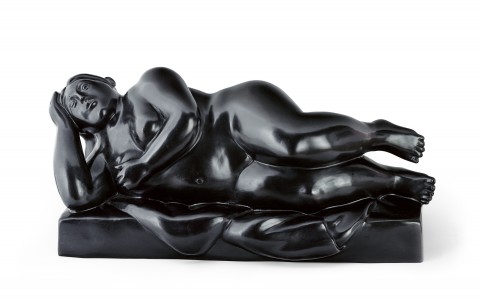RECLINING WOMAN (DONNA SDRAIATA), 2009
FERNANDO BOTERO
bronze
54.5 x 27.0 x 22.0 cm
signed and numbered at base: Botero 6/6.
Private collection, acquired directly from the artist
David Benrimon Fine Art, New York
Private collection, Melbourne, acquired from the above in November 2012
Accompanied by a copy of the original certificate of authenticity from the artist.
image001 (11).jpg

Santo Augustino’s Church in Pietrasanta,Tuscany, prior
the opening of ‘Fernando Botero: designer and sculptor’
exhibition on July 6, 2012
‘In the history of sculpture, eighty percent of the subject matter has been a woman, either reclining standing or seated. It is a great tribute paid to the most beautiful form of nature. The interesting thing is that in returning to the same subject, you always say something different.’1
Renowned Colombian painter and sculptor Fernando Botero almost requires no introduction, he’s an enduring popular hero of Latin America. The whimsical stylisation of his rotund figures and objects have coined a new term, Boterismo, and are instantly recognisable from his extensive oeuvre of drawings, paintings and sculptures. While Botero’s career began with painting, it was through the medium of sculpture during the mid-1970s that his fascination with the plasticity of inflated, curvaceous forms was best conveyed. In bronze and marble, the confluence of taut volumes and smooth shining surfaces is masterfully used by Botero, and most often applied to anonymous and archetypal female forms. With blank expressions and unfurrowed brows, the inhabitants of Botero’s universe are placid and languorous, occasionally represented smoking a cigarette or holding an apple. Donna Sdraiata, 2009 is a magnificent example of the sculptor’s reclining female nudes. Featuring a simple composition upon a cloth, Botero highlights the smooth surfaces and soft, supple textures paradoxically conveyed by the gleaming bronze.
Botero spent three years living and working in Italy at the start of his career, and having imbibed this visual culture, Renaissance tropes began to inform his artistic compositions in painting and sculpture. Instead of working live models, Botero relies on his visual memory and other artistic appropriations. In reprising the classical theme of the reclining female nude, Botero found the perfect vehicle to explore again and again an overtly sensuous female form, working within the pre-determined confines of well-known theme of Western Art history. He has created many versions of the Donna Sdraiata, the reclining woman, between 1984 – 2009, often in a monumental size, including Reclining Nude, 1984 (Birmingham Museum of Art, USA and Museum of Modern Art, Saitama, Japan), Reclining Woman, 1993 (Kunstmuseum Leichtenstein, Lichtenstein) and Donna Sdraiata, 2003 (Ekebergparken, Olso, Norway), sculptures which are all closely related to one another.
The plump limbs of these languid women caught in their reverie spill over the edges of their plinths. Many of Botero’s sculpted rectangular bases also have a plump, pillowy aspect, emphasising the inherent material contradiction with the bronze and marble of which they are made. With an almost comic disregard for exact proportions, Botero emphasises the physical and plastic impact of a generous figure rather than the elegant poise expected of a classical reclining nude. This Reclining Woman, unlike her more relaxed and licentious counterparts, is alert, poised to leap up. While her gaze is loftily disengaged, she is modest, curled on her side, with an arm covering her chest. Innocently removed from the dangers of the real world, Botero’s figures are unaware of our presence, and the viewer necessarily becomes a voyeur.
Botero comes from and depicts in turn Colombian mestizo culture – hybridising Castilian conservatism and elements of indigenous Amerindian culture, striving to humanize visual representations of Latin American culture.2 Considered by some academics to be humorous caricatures of the upper classes of the conquistadors of Latin America, Botero’s figures display humanist ideals in their accessibility and anonymity. Botero’s art is democratic, easily legible, and accessible to viewers of all ages, particularly when publicly installed and displayed in a monumental format. While the influence of classical Western Renaissance art is evident in Botero’s works, he remains engaged with Latin American concerns and subject matter, invoking the ‘atmospheres and characters of all the paisa cultures in which [he] has lived’.3
1. Fernando Botero, March 2021, quoted in Zest and Curiosity, [https://www.zestandcuriosity.com/2021/01/03/botero/] (accessed 4/11/21)
2. ibid.
3. Chow Kian, K., and Willie, V., Botero in Singapore, Singapore Art Museum, 2004, p. 30
LUCIE REEVES-SMITH
